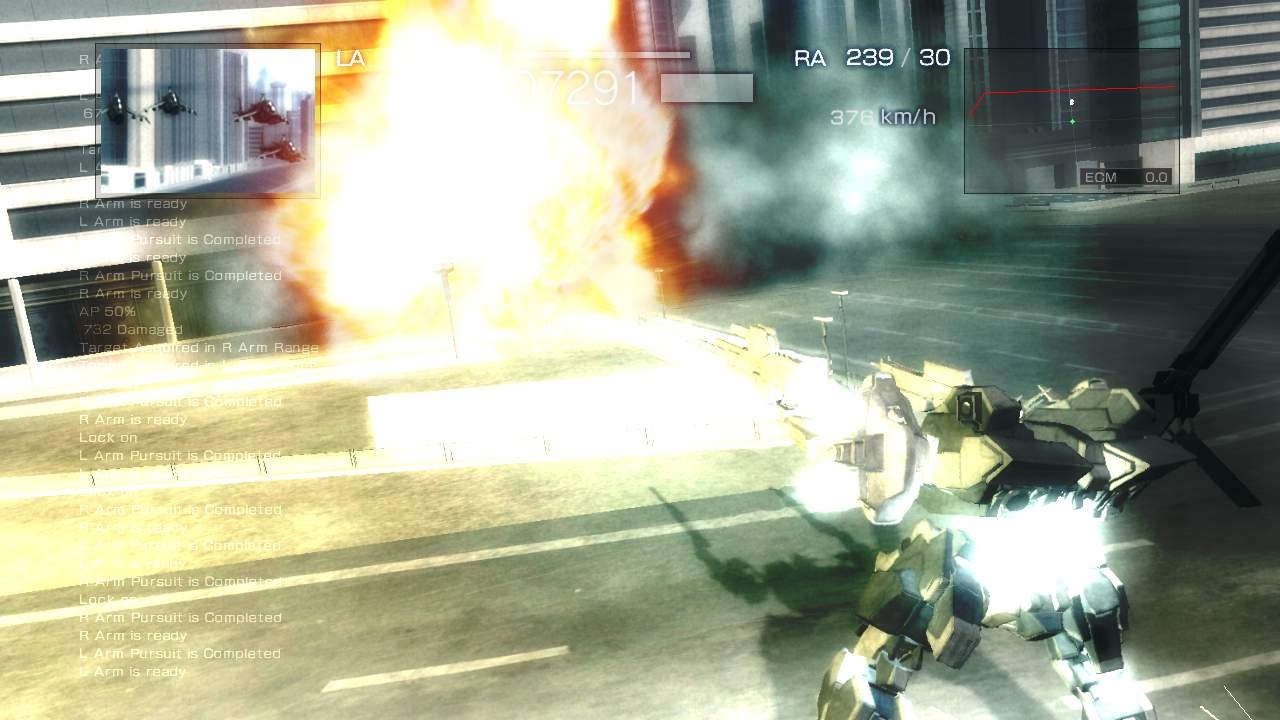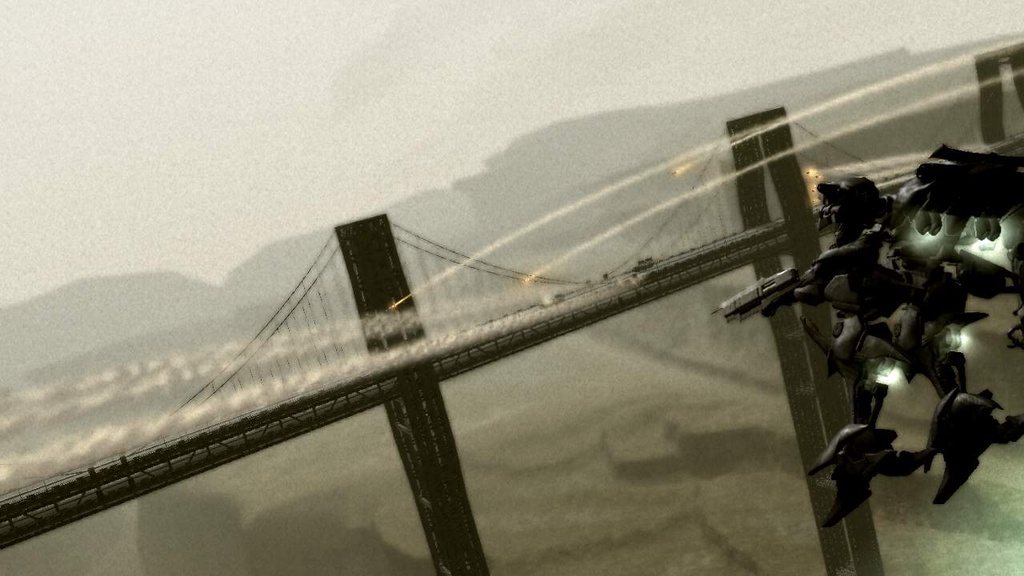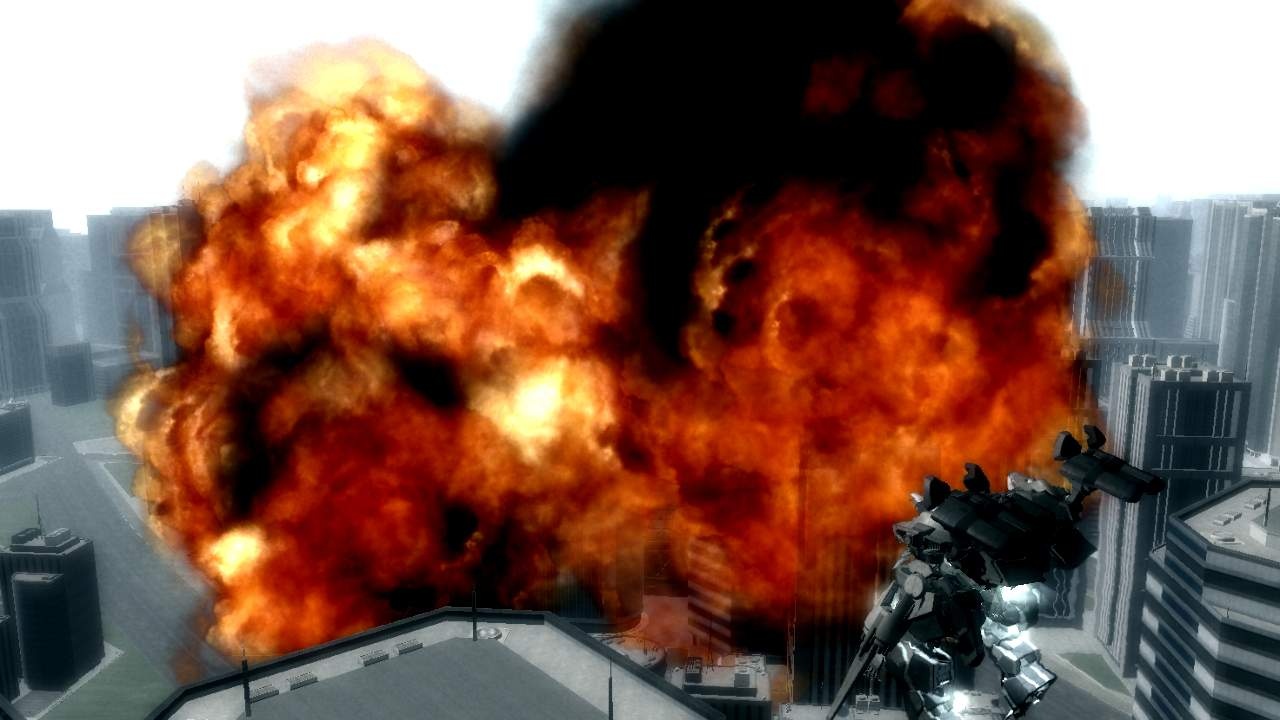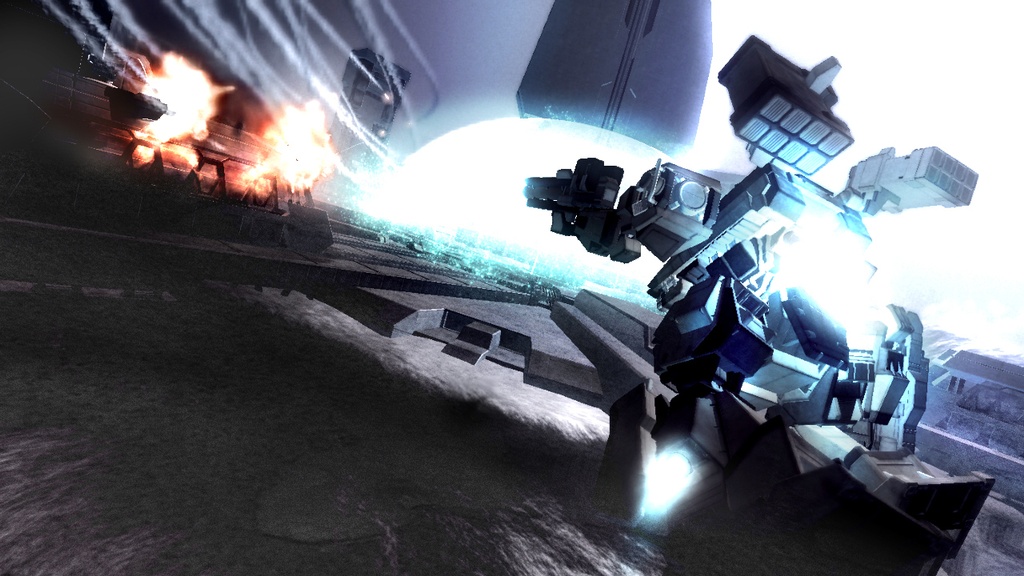Mech games come in two varieties. You've got the West's MechWarrior tradition, characterized by hulking, barbaric monstrosities, and the East's Gundam or Macross tradition, characterized by lithe and agile bots. With the release of Chromehounds last year, From Software seems to want to corner the mech market, offering the best of the East and the West. And with Chromehounds accommodating the grognard sect, it seems only natural that Armored Core's already booster-engine-friendly action would transition out of that market in favor of the fast-paced arcade-style experience. In many ways, Armored Core 4 trims the fat from the series, removing or toning down some of the interesting but not particularly well-executed aspects of the game. But to compensate, the developers layered on a heaping helping of butter by ramping up the intensity and action, as well as simplifying the mech-building process. However you cook it, Armored Core 4 offers a delightfully unhealthy amount of mech-busting fun.

For six-and-a-half years and seven games, the Armored Core faithful have been pining for a graphical update. That update has now arrived. From an artistic standpoint, AC4 looks as you'd expect from a world exposed to one ecologically obliterating war after another. The whole game has an overexposed, grainy aesthetic that really immerses you in the foul state the world has deteriorated into. Depth of field is heavily relied upon to blur out distant objects, which further adds a hazy and surreal quality to the game's appearance. AC4 also shines from a technical standpoint. Lighting, in particular, is phenomenally well done, from the way your boosters illuminate your mech in the night to the way billowing clouds of dark, oily smoke blot out the sun and darken the environment. Particle effects look really good, and in a first for the series, the game's environments are fairly destructible, as buildings will partially collapse under heavy fire and certain environments break apart. Further, the frame rate is for the most part rock steady, but it does drop to a crawl if you're given a rocket-barrage sandwich. And this will occasionally happen, as there's definitely a lot more ordnance flying every which way than before.
Armored Core 4's graphics do have a few notable faults, however. Namely, though collision detection is spot-on when it comes to enemies, your mech's lower extremities and weapons will occasionally clip through particularly hilly areas of the environments. Also, destroyed mechs and other debris pretty much disappear as soon as they're destroyed, which means you can't take pride in your wake of carnage after the fact. Lastly, this game is meant to be played in high definition, as it's here that the lighting and detail on the mechs really pop. In standard def, the graphics are still decent, but their impact is greatly diminished. The Xbox 360 version and PS3 version are functionally the same in nearly every respect, but you will find that, surprisingly, the Xbox 360 version will look a tad better, particularly in atmospheric particle effects. Otherwise, the only real difference between the two is the 360's achievement points.
Overall, AC4 is a much faster, more visceral experience than previous games in the series. The foremost reason behind this is the completely redesigned boost mechanic. In the past, you were given a fairly limited amount of energy that quickly drained every time you engaged your boost, and if you weren't careful, it would bottom out and you'd be left to plod along as you waited for it to recharge. In AC4, that design has pretty much been tossed out the window, because now if you aren't boosting, you're either dead or soon will be. Your energy now drops only when you go vertical or when you activate the game's new boost option, the quick boost. Quick boost eats up a chunk of energy in exchange for a burst of speed in whichever direction you indicate, and it acts as an evasive maneuver or as a way to cover a lot of ground quickly. Even better, you no longer need to worry about overheating or bottoming out your energy meter, as the coolant mechanic has been removed.
With those shiny new boosters, you're going to want space to really cut loose, and Armored Core 4 accommodates. In the past, you were limited by a fairly rigid boundary limit, where you could go only so high or so far before warning lights flashed and you were charged with dereliction. While those limits still exist, they're not anywhere near as confining as they were. So you can now fly to the top of towering structures and rain death down below, engage in prolonged aerial combat with helicopters or other zippy mechs, or speed through a sprawling city, pausing only to bust up a cadre of simpletons who have a mind to bring you down--as if.
The logical progression of 'roiding up the graphics and opening up the environments to accommodate for the faster and more furious gameplay is to design missions that speak directly to these assets. The storyline plays out over the course of 37 missions, and these are kept fresh and varied by giving you objectives other than just kill-'em-all, though you'll occasionally do that, too. Whether it's blasting out of the sky waves and waves of self-guided missiles, working your way through pitch-black night to destroy an experimental weapon, or just going one-on-one with a highly skilled enemy merc, the action is intense and satisfying. Strategy is more heavily emphasized, as well, and if you fail on your first attempt, you'll typically have a good idea on which weapons loadout to try on your next attempt. And really, it's often just as fun to fail as it is to succeed. This is because From Software has done a significantly better job of reducing the frustration level of many missions by making failures feel less arbitrary. There's always a sense that when you fail, it is your fault, not that of the game being cheap.

An unfortunate holdover from previous AC games is that missions are still entirely too short, lasting no longer than five minutes and occasionally less than 60 seconds. It can be absurdly unsatisfying to find that you've accomplished your mission just as the action was heating up. What's worse is that you're often still in quite a precarious situation when many missions end, so it seems as though a good many of them could have been quite naturally extended by requiring you to escape after you've infiltrated. As it is, they end with an abrupt invulnerability and an accompanying "Please return to base" message once you complete your objective.
Aside from revamping the boost mechanic and opening up the environments, the other significant alteration to the Armored Core formula is primal armor. Cores now come equipped with PA, which is a force field of sorts and is fueled by that which fuels many an ardent Metal Gear Solid devotee, Kojima. In AC4, Kojima is a recently developed technology that acts essentially like nuclear radiation, as it decimates the environment and kills anyone not insulated from it. But, it is highly effective as a military instrument, so in true-to-life fashion, it's been implemented on a wide scale. The primal armor system works quite well, and it adds an interesting dynamic, especially to fights against enemy Nexts, which are the advanced mech suits that you and the other skilled mercenaries pilot. Weapons now have a PA piercing and PA reduction stat, and these significantly play into your loadout choices when you square off against one of your fellow mechanized killers.
If one thing can be said about the AC series, it's that From Software has no qualms with tweaking the assembly interface. Throwing together a mech and seeing how it runs has traditionally been the meat of the Armored Core experience, and to the potential dismay of series vets and the unbridled glee of everyone else, this aspect of the game has been slightly deemphasized. To begin with, you're no longer given a stock mech and a fistful of cash and then left to your own devices. Schematics are the name of the game this time around, and they're essentially prebuilt mechs that have their attack, mobility, defense, and armor points rating numerically represented. This means you can jump right into a fully functional mech that is already well on its way to matching your play style. The tweaking process has subsequently been streamlined by combining the shopping and assembly interfaces. Initially, this can be quite confusing because you don't automatically equip an item once you buy it, and items that you sell aren't automatically unequipped. So if you leave the garage with an item you no longer own equipped, you'll be prompted to purchase that item (or items) without being told what it is, exactly, you're about to buy. This can be especially frustrating if you don't have enough cash for the purchase, because you then have to go back through each item to see what it is you forgot to equip. You quickly learn to keep better track of what you're doing, but initially it can cause a serious headache.

But on the whole, customization has been made more transparent to newcomers. Unlike the baffling 20-odd helmets and 50 or more weapons that were immediately thrown at you in the last installment of this series, equipment is now slowly unlocked as you progress through the game's chapters. Your choices, then, are fairly limited in the beginning, which makes it significantly easier to compute how the various parts fit together. It is a bit of a drag, though, that while there is a good number of new types of weapons that eventually become available, what are unlocked are mostly just upgraded versions of what you already have. Also, AC4 still relies too heavily on ambiguous abbreviations for certain stats. Between your EN, KP, PA, FCS, and FRS, it can get pretty confusing. A lot of the finer tuning can now be done automatically, which also helps. For instance, instead of being awarded points to individually tune parts, you are now allocated fractional regulation system (FRS) points by completing the game's chapters, as well as completing the game's data packs. Giving the CPU control here won't be as efficient as fine-tuning everything yourself, but it certainly simplifies the process and makes the whole system more approachable.
A coherent storyline has never factored into the Armored Core equation, and such is also the case in AC4. The world is once again under the totalitarian control of a group of superpower companies, and humanity is subjugated to the group's will. Some folks aren't keen on this type of existence, so you're hired by a small colony and allied with an antiquated company to essentially wage guerrilla warfare on the major companies and take them out. It's pretty much a mess, but whatever--you're a mercenary. It's your job to shut your mouth, do what you're told, and get paid if you survive. As it pertains to the game, the story justifies your globetrotting because events transpire on a global level and your missions aren't limited to a specific region. In fact, you'll regularly bounce from America's verdant fields to Antarctica's frigid ice caps to the sea-swallowed former Shanghai. The story is told with the same aloof and chilling tone that characterizes the series, where neutralizing equates to slaughtering and casualties are rated on an acceptable versus unacceptable scale. The actors voicing the story do a uniformly excellent job, with an erudite-sounding narrator between chapter cutscenes and an emotive mission debriefer whose tone gradually shifts from professional to emotionally invested.
The soundtrack has also gotten some much-needed attention this time around, as it sloughs off the techno-heavy beats of many of the prior games and replaces them with some really standout tunes, including a truly epic chanting-chorus ensemble with a wailing guitar and heavy drum beats. It's also nice that it accompanies rather than trumps the action, and plays at a subdued din as the sound effects from the environment and your weapons scream to the forefront. Given how well the soundtrack is integrated into the game, and because it just rocks, it's a shame there isn't much variety to it, as there only seem to be four or five different tracks.

Aside from the storyline, you've got data packs and online multiplayer to flesh out the experience. Data packs are unlocked over the course of the game, and they essentially replace the arena from past games. They pit you against top-ranked Nexts, and when you defeat these pilots, you're rewarded with their schematic, emblem, and FRS, as well as achievement points in the Xbox 360 version. These fights can be extremely challenging, and you'll probably need to do extensive customization to hold your ground against these opponents. Online battling has been a much-anticipated feature for longtime AC followers. After all, what's the point of spending hours upon hours devising color schemes and weapon loadouts for your mech if you can't blow the mind of some easily impressionable youth in Xenia, Ohio? Unfortunately, online play doesn't offer much to get excited about. There are only a few different maps, and the ones available are tantamount to open, featureless fields. Your gameplay options are also severely limited, as you'll have access to only the bare-bones one-on-one to four-on-four matches, as well as a four- or eight-player battle royal. The action itself holds up quite nicely, however, and it can be a lot of fun to humiliate your friends by reducing their pride and joy to a flaming heap of scrap. You're also able to trade schematics online, but there doesn't seem to be away to check out other people's schematics without freeing up your FRS to accommodate the other person's settings, which is a massive hassle. All in all, the online functionality is a fairly lackluster effort, but at least it lays the groundwork for future installments.
Between the streamlined assembly process, the retooled control scheme, and the junking of the cooling system and other mechanics that slowed down the action, Armored Core 4 is far more approachable game than previous installments in the series. Its heavier emphasis on arcade-style mech-on-mech action also means that its enhanced fast-paced action will appeal to a more mainstream audience. And even though it isn't as complex as it once was, there's still plenty to obsess over for the hardcore lot. Suffice it to say, yes, really, this is a very good mech combat game.



